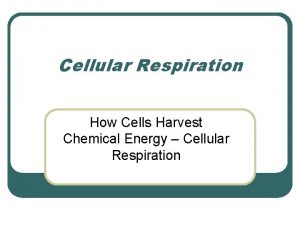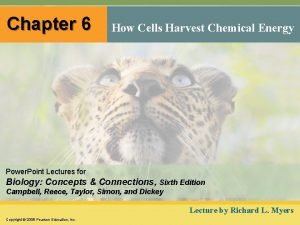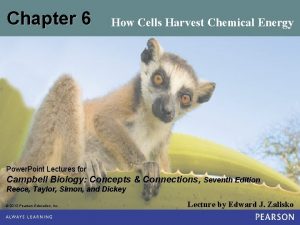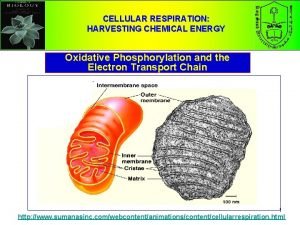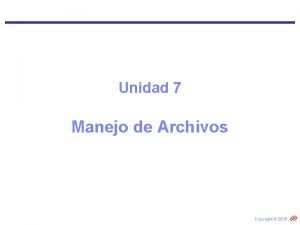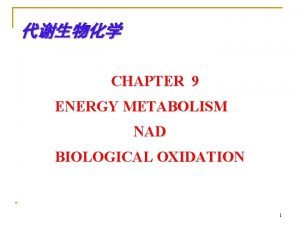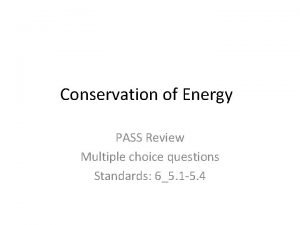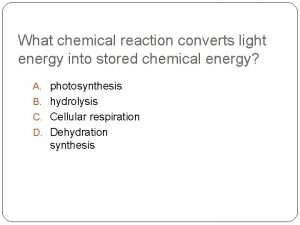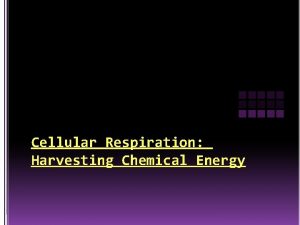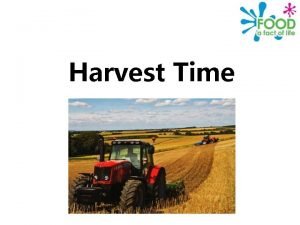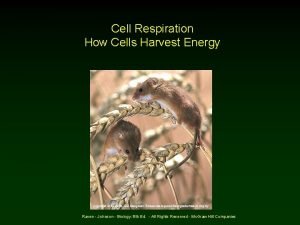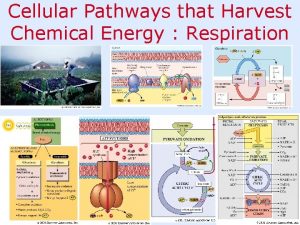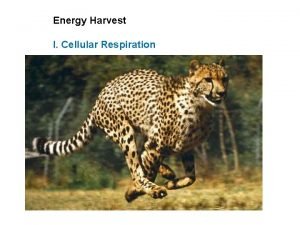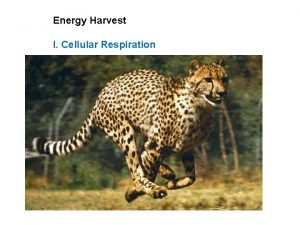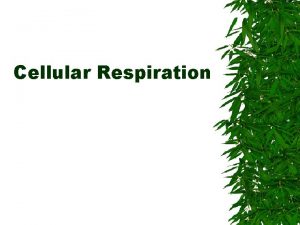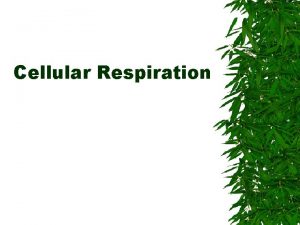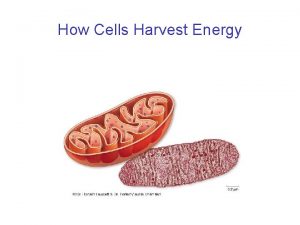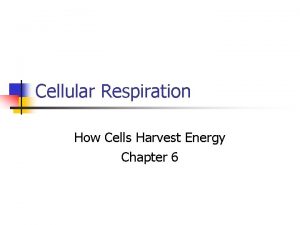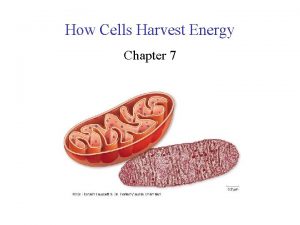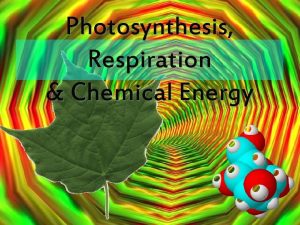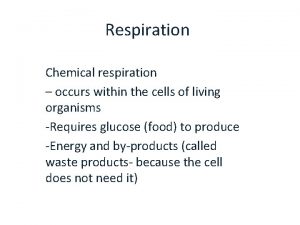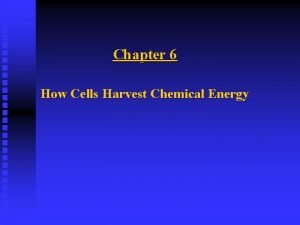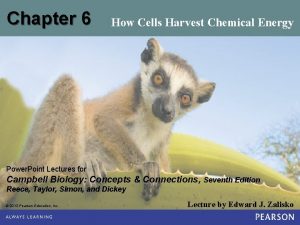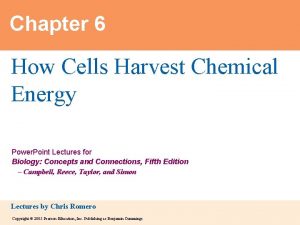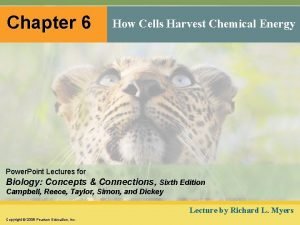Respiration How Cells Harvest Chemical Energy Copyright 2005







































- Slides: 39

Respiration How Cells Harvest Chemical Energy Copyright © 2005 Pearson Education, Inc. Publishing as Benjamin Cummings

INTRODUCTION TO CELLULAR RESPIRATION 6. 1 Photosynthesis and cellular respiration provide energy for life • Cellular respiration makes ATP and consumes O 2 – During the oxidation of glucose to CO 2 and H 2 O Copyright © 2005 Pearson Education, Inc. Publishing as Benjamin Cummings

• Photosynthesis uses solar energy To produce glucose and O 2 from CO 2 and H 2 O Sunlight energy ECOSYSTEM Photosynthesis in chloroplasts CO 2 Glucose + + H 2 O O 2 Cellular respiration in mitochondria ATP (for cellular work) Heat energy Figure 6. 1 Copyright © 2005 Pearson Education, Inc. Publishing as Benjamin Cummings

6. 2 Breathing supplies oxygen to our cells and removes carbon dioxide • Breathing provides for the exchange of O 2 and CO 2 between an organism and its environment O 2 CO 2 Breathing Lungs CO 2 Bloodstream O 2 Muscle cells carrying out Cellular Respiration Glucose + O 2 Figure 6. 2 Copyright © 2005 Pearson Education, Inc. Publishing as Benjamin Cummings CO 2 + H 2 O + ATP

6. 3 Cellular respiration stores energy in ATP molecules • Cellular respiration breaks down glucose molecules – And stores their energy in ATP C 6 H 12 O 6 Glucose + 6 O 2 Oxygen gas Figure 6. 3 Copyright © 2005 Pearson Education, Inc. Publishing as Benjamin Cummings 6 CO 2 Carbon dioxide + 6 H 2 O Water + ATPs Energy

6. 4 The human body uses energy from ATP for all its activities ATP powers almost all cellular and body activities Table 6. 4 Copyright © 2005 Pearson Education, Inc. Publishing as Benjamin Cummings

6. 5 Cells tap energy from electrons “falling” from organic fuels to oxygen • Electrons lose potential energy – During their transfer from organic compounds to oxygen Copyright © 2005 Pearson Education, Inc. Publishing as Benjamin Cummings

• When glucose is converted to carbon dioxide – It loses hydrogen atoms, which are added to oxygen, producing water Loss of hydrogen atoms (oxidation) C 6 H 12 O 6 + 6 O 2 6 CO 2 + Glucose 6 H 2 O + Energy (ATP) Gain of hydrogen atoms (reduction) Figure 6. 5 A Copyright © 2005 Pearson Education, Inc. Publishing as Benjamin Cummings

• Dehydrogenase removes electrons (in hydrogen atoms) from fuel molecules (oxidation) – And transfers them to NAD+ (reduction) H NAD+ Oxidation H O Reduction 2 H + + 2 H O + 2 H Dehydrogenase + 2 e Figure 6. 5 B Copyright © 2005 Pearson Education, Inc. Publishing as Benjamin Cummings NADH (carries 2 electrons) + H+

• NADH passes electrons to an electron transport chain • As electrons “fall” from carrier to carrier and finally to O 2 – Energy is released in small quantities NADH NAD+ + �ATP 2 e Controlled release of energy for synthesis of ATP H+ El ec tro n ch tra ain ns po rt 2 e 2 1 2 H+ H 2 O Figure 6. 5 C Copyright © 2005 Pearson Education, Inc. Publishing as Benjamin Cummings O 2

STAGES OF CELLULAR RESPIRATION AND FERMENTATION • 6. 6 Overview: Cellular respiration occurs in three main stages • Cellular respiration – Occurs in three main stages Copyright © 2005 Pearson Education, Inc. Publishing as Benjamin Cummings

• Stage 1: Glycolysis – Occurs in the cytoplasm – Breaks down glucose into pyruvate, producing a small amount of ATP Copyright © 2005 Pearson Education, Inc. Publishing as Benjamin Cummings

• Stage 2: The citric acid cycle – Takes place in the mitochondria – Completes the breakdown of glucose, producing a small amount of ATP – Supplies the third stage of cellular respiration with electrons Copyright © 2005 Pearson Education, Inc. Publishing as Benjamin Cummings

• Stage 3: Oxidative phosphorylation – Occurs in the mitochondria – Uses the energy released by “falling” electrons to pump H+ across a membrane – Harnesses the energy of the H+ gradient through chemiosmosis, producing ATP Copyright © 2005 Pearson Education, Inc. Publishing as Benjamin Cummings

• An overview of cellular respiration NADH High-energy electrons carried by NADH FADH 2 and GLYCOLYSIS Glucose Pyruvate CITRIC ACID CYCLE OXIDATIVE PHOSPHORYLATION (Electron Transport and Chemiosmosis) Mitochondrion Cytoplasm ATP Substrate-level phosphorylation CO 2 ATP CO 2 Substrate-level phosphorylation Figure 6. 6 Copyright © 2005 Pearson Education, Inc. Publishing as Benjamin Cummings ATP Oxidative phosphorylation

6. 7 Glycolysis harvests chemical energy by oxidizing glucose to pyruvate • In glycolysis, ATP is used to energize a glucose molecule – Which is split into two molecules of pyruvate NAD 2 2 NADH + 2 H Glucose 2 Pyruvate 2 ADP Figure 6. 7 A Copyright © 2005 Pearson Education, Inc. Publishing as Benjamin Cummings +2 P 2 ATP

• Glycolysis produces ATP by substrate-level phosphorylation In which a phosphate group is transferred from an organic molecule to ADP Figure 6. 7 B Copyright © 2005 Pearson Education, Inc. Publishing as Benjamin Cummings

The conversion of phosphoenolpyruvate to pyruvate is another example of substrate level phosphorylation. Copyright © 2005 Pearson Education, Inc. Publishing as Benjamin Cummings

• In the first phase of glycolysis – ATP is used to energize a glucose molecule, which is then split in two Steps 1 – 3 A fuel molecule is energized, using ATP. Glucose ATP PREPARATORY PHASE (energy investment) Step 1 ADP P Glucose-6 -phosphate P Fructose-1, 6 -diphosphate 2 ATP 3 ADP P Step 4 A six-carbon intermediate splits into two three-carbon intermediates. Figure 6. 7 C Copyright © 2005 Pearson Education, Inc. Publishing as Benjamin Cummings 4

• In the second phase of glycolysis – ATP, NADH, and pyruvate are formed P Step 5 A redox reaction generates 6 9 NADH. NAD P 5 +H P ADP P P 1, 3 -Diphosphoglycerate 6 7 6 ATP P P 7 P 8 8 H 2 O 8 2 -Phosphoglycerate 8 H 2 O P P 9 ADP Phosphoenolpyruvate (PEP) 9 ADP 9 Copyright © 2005 Pearson Education, Inc. Publishing as Benjamin Cummings 7 P 3 -Phosphoglycerate 7 Figure 6. 7 C 6 ADP ATP ENERGY PAYOFF PHASE 5 P 6 NADH +H P P NADH Steps 6 – 9 ATP and pyruvate are produced. NAD Glyceraldehyde-3 -phosphate (G 3 P) 9 ATP Pyruvate

Copyright © 2005 Pearson Education, Inc. Publishing as Benjamin Cummings

6. 8 The Link reaction (between glycolysis and Citric acid cycle) • Prior to the citric acid cycle – Enzymes process pyruvate, releasing CO 2 and producing NADH and acetyl Co. A NADH H 2 Co. A Pyruvate 1 3 CO 2 Figure 6. 8 Copyright © 2005 Pearson Education, Inc. Publishing as Benjamin Cummings Coenzyme A Acetyl Co. A (acetyl coenzyme A)

When pyruvate enters the matrix of mitochondria it is converted to acetyl. Co. A. Coenzyme A (Co. A) is a large molecule (and a vitamin) that acts as a coenzyme. The conversion of pyruvate to acetyl. Co. A is an coupled oxidation-reduction reaction in which high energy electrons are removed from pyruvate and end up in NADH. The three carbon pyruvate is split into CO 2 and the two carbon acetate. Copyright © 2005 Pearson Education, Inc. Publishing as Benjamin Cummings

6. 9 The citric acid cycle completes the oxidation of organic fuel, generating many NADH and FADH 2 molecules Acetyl Co. A • In the citric acid cycle Co. A The two-carbon acetyl part of acetyl Co. A is oxidized 2 CO 2 CITRIC ACID CYCLE 3 FADH 2 3 FAD NAD+ NADH + 3 H+ ATP Figure 6. 9 A Copyright © 2005 Pearson Education, Inc. Publishing as Benjamin Cummings ADP + P

• The two carbons are added to a four-carbon compound, forming citrate – Which is then degraded back to the starting compound Copyright © 2005 Pearson Education, Inc. Publishing as Benjamin Cummings

• For each turn of the cycle Co. A Acetyl Co. A Two CO 2 molecules are released The energy yield is one ATP, three NADH, and one FADH 2 2 carbons enter cycle Oxaloacetate Citrate NADH H CO 2 NAD CITRIC ACID CYCLE leaves cycle NAD 1 Malate NADH ADP 5 FADH 2 H P ATP 2 Alpha-ketoglutarate FAD CO 2 4 3 Step Acetyl Co. A stokes the furnace. 1 Figure 6. 9 B Copyright © 2005 Pearson Education, Inc. Publishing as Benjamin Cummings leaves cycle Succinate Steps 2 NADH and H NAD Steps and NADH, ATP, and CO 2 are generated during Redox reactions generate FADH and 2 4 3 5 redox reactions. NADH.

Copyright © 2005 Pearson Education, Inc. Publishing as Benjamin Cummings

6. 10 Most ATP production occurs by oxidative phosphorylation • Electrons from NADH and FADH 2 – Travel down the electron transport chain to oxygen, which picks up H+ to form water • Energy released by the redox reactions – Is used to pump H+ into the space between the mitochondrial membranes Copyright © 2005 Pearson Education, Inc. Publishing as Benjamin Cummings

• In chemiosmosis, the H+ diffuses back through the inner membrane through ATP synthase complexes --Driving the synthesis of ATP H+ H+ Protein complex H H+ H+ Electron carrier Intermembrane space H+ + H+ H+ ATP synthase Inner mitochondrial membrane FADH 2 Electron flow NAD+ NADH Mitochondrial matrix FAD H+ 1 O 2 + 2 H+ H+ Electron Transport Chain OXIDATIVE PHOSPHORYLATION Figure 6. 10 Copyright © 2005 Pearson Education, Inc. Publishing as Benjamin Cummings H 2 O ADP P ATP H+ Chemiosmosis

CONNECTION 6. 11 Certain poisons interrupt critical events in cellular respiration Cyanide, carbon monoxide Rotenone Block the movement of electrons H+ H+ H+ Block the flow of H+ through ATP synthase Oligomycin H+ H+ H+ Allow H+ to leak through the membrane + ATP Synthase DNP FADH 2 FAD 1 O 2 2 H+ 2 NAD+ NADH H+ H+ H+ Electron Transport Chain Figure 6. 11 Copyright © 2005 Pearson Education, Inc. Publishing as Benjamin Cummings H 2 O ADP P ATP Chemiosmosis

6. 12 Review: Each molecule of glucose yields many molecules of ATP (38) Figure 6. 12 Copyright © 2005 Pearson Education, Inc. Publishing as Benjamin Cummings

6. 13 Fermentation is an anaerobic alternative to cellular respiration • Under anaerobic conditions, many kinds of cells – Can use glycolysis alone to produce small amounts of ATP Copyright © 2005 Pearson Education, Inc. Publishing as Benjamin Cummings

• In lactic acid fermentation – NADH is oxidized to NAD+ as pyruvate is reduced to lactate 2 NAD 2 2 NADH 2 NAD GLYCOLYSIS 2 ADP 2 Glucose P 2 ATP 2 Pyruvate Figure 6. 13 A Copyright © 2005 Pearson Education, Inc. Publishing as Benjamin Cummings 2 Lactate

• In alcohol fermentation – NADH is oxidized to NAD+ while converting pyruvate to CO 2 and ethanol 2 NADH NAD 2 GLYCOLYSIS 2 ADP 2 P Glucose 2 2 ATP CO 2 released 2 Ethanol �� 2 Pyruvate Figure 6. 13 B Figure 6. 13 C Copyright © 2005 Pearson Education, Inc. Publishing as Benjamin Cummings

INTERCONNECTIONS BETWEEN MOLECULAR BREAKDOWN AND SYNTHESIS • 6. 14 Cells use many kinds of organic molecules as fuel for cellular respiration Copyright © 2005 Pearson Education, Inc. Publishing as Benjamin Cummings

• Carbohydrates, fats, and proteins can all fuel cellular respiration – When they are converted to molecules that enter glycolysis or the citric acid cycle Food, such as peanuts Carbohydrates Fats Sugars Glycerol Proteins Fatty acids Amino groups Glucose G 3 P Pyruvate Acetyl Co. A GLYCOLYSIS ATP Figure 6. 14 Copyright © 2005 Pearson Education, Inc. Publishing as Benjamin Cummings CITRIC ACID CYCLE OXIDATIVE PHOSPHORYLATION (Electron Transport and Chemiosmosis)

• • • Proteins must first be digested to individual a____ acids. Amino acids that will be catabolized must have their amino groups removed via deamination. The carbon skeletons are modified by enzymes and enter as intermediaries into glycolysis or the citric acid cycle, depending on their structure. Copyright © 2005 Pearson Education, Inc. Publishing as Benjamin Cummings

6. 15 Intermediates from glycolysis and the citric acid cycle are used as raw materials for making complex organic ATP needed to drive biosynthesis ATP substances CITRIC ACID CYCLE GLUCOSE SYNTHESIS Acetyl Co. A Pyruvate G 3 P Glucose Amino groups Amino acids Proteins Fatty acids Glycerol Fats Cells, tissues, organisms Figure 6. 15 Copyright © 2005 Pearson Education, Inc. Publishing as Benjamin Cummings Sugars Carbohydrates

6. 16 The fuel for respiration ultimately comes from photosynthesis • All organisms – Can harvest energy from organic molecules • Plants – make these molecules from inorganic sources by the process of photosynthesis Figure 6. 16 Copyright © 2005 Pearson Education, Inc. Publishing as Benjamin Cummings
 How cells harvest chemical energy
How cells harvest chemical energy Chapter 6 how cells harvest chemical energy
Chapter 6 how cells harvest chemical energy Chapter 6 how cells harvest chemical energy
Chapter 6 how cells harvest chemical energy Chapter 9 cellular respiration harvesting chemical energy
Chapter 9 cellular respiration harvesting chemical energy Explain how amp stimulates cellular respiration
Explain how amp stimulates cellular respiration Chapter 9: cellular respiration: harvesting chemical energy
Chapter 9: cellular respiration: harvesting chemical energy Phosphorelation
Phosphorelation External respiration vs internal respiration
External respiration vs internal respiration Internal and external respiration
Internal and external respiration Pearson education inc publishing
Pearson education inc publishing Copyright 2005
Copyright 2005 2005 pearson prentice hall inc
2005 pearson prentice hall inc Copyright 2005
Copyright 2005 Copyright 2005
Copyright 2005 Copyright 2005
Copyright 2005 Copyright 2005
Copyright 2005 Pearson
Pearson Copyright 2005
Copyright 2005 Copyright 2005
Copyright 2005 Energy harvest
Energy harvest Onodi cells
Onodi cells Proximal convoluted tubule
Proximal convoluted tubule Thyroid gland
Thyroid gland Gamete vs somatic cell
Gamete vs somatic cell Somatic cells vs germ cells
Somatic cells vs germ cells Red blood cells and white blood cells difference
Red blood cells and white blood cells difference Prokaryotic v. eukaryotic cells
Prokaryotic v. eukaryotic cells Venn diagram animal and plant cells
Venn diagram animal and plant cells Prokaryotic cell
Prokaryotic cell Organelle trail
Organelle trail Masses of cells form and steal nutrients from healthy cells
Masses of cells form and steal nutrients from healthy cells Pseudostratified vs simple columnar
Pseudostratified vs simple columnar What animals have prokaryotic cells
What animals have prokaryotic cells Prokaryotic cells
Prokaryotic cells Nondisjunction in meiosis
Nondisjunction in meiosis Cells cells they're made of organelles meme
Cells cells they're made of organelles meme Usable chemical energy in food begins as __________ energy.
Usable chemical energy in food begins as __________ energy. ________ converts light energy into chemical energy. *
________ converts light energy into chemical energy. * Potential energy examples
Potential energy examples Photosynthesis transforms light energy into chemical energy
Photosynthesis transforms light energy into chemical energy
